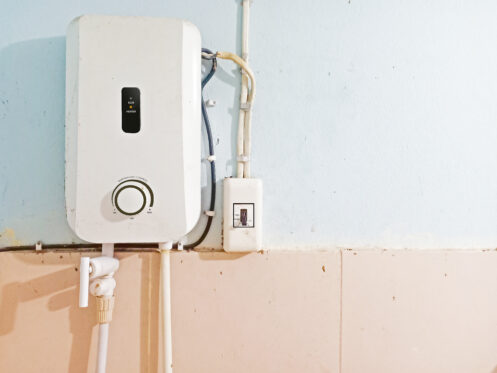For quite some time, tank-based water heaters were the standard for residential water heating. Now, however, many homeowners in Modesto, CA are replacing their storage-based units with tankless models. Tankless water heaters provide hot water on demand. They have a much more compact size, and they require a lot less maintenance. While tankless water heaters also enjoy significantly longer lifespans, they aren’t guaranteed to work well for every household. Read on to find out how tanked and tankless water heaters stack up.
Tank-Based Water Heaters and Standby Energy Losses
When comparing tanked and tankless water heaters, one of the most important things to consider is the cost of standby energy losses. Standby energy losses represent the fuel and heat energy that’s wasted when water is held in storage tanks until distribution. Standard, storage-based water heaters fill to capacity with cool water, heat this water up, and then store it indefinitely. While holding it, they periodically reheat it to replace the heat that escapes through their tank walls.
To compare, tankless water heaters experience no standby energy losses. Instead, these units only heat water when hot water is demanded at connected taps or appliances. According to the United States Department of Energy (DOE), this factor alone makes tankless water heaters at least 8% more efficient than storage-based designs and as much as 34% more efficient.
Standby Energy Losses in Gas-Fired Water Heaters With Pilot Lights
If you have an older, tanked, gas-fired water heater in your home, there are more standby energy losses to account for. Many older models have gas-burning pilot lights. Thus, in addition to burning fuel to replace lost heat energy during storage, these units constantly use gas to keep their pilots lit. While switching to a tankless water heater will eliminate these losses entirely, you can also get rid of pilot-related energy losses by simply upgrading to a more modern storage-based water heater. All new tanked water heaters come with electronic ignition switches.
Strategies for Mitigating Standby Energy Losses
In addition to upgrading older water heaters with pilot lights to models with electronic ignition switches, homeowners can also insulate their water heater tanks. Tanked water heaters experience far fewer energy losses when they’re wrapped in fitted, foam insulation blankets and have pipe sleeves made from neoprene or polyethylene foam. The DOE asserts that properly insulating a storage-based water heater could cut energy losses by up to 45% for savings on overall water heating costs of up to 16%.
Tankless Water Heaters and Performance Limitations
When it comes to efficiency, tankless water heaters are the clear winner. With no standby energy losses and electronic starting mechanisms, they might seem like the ideal choice for your home. However, they do have limitations.
When you hear people laud the benefits of tankless water heating, you’ll often hear terms like “on-demand water heating” and “unlimited water heating” used interchangeably. Unfortunately, on-demand and unlimited don’t mean the same thing, and supply issues are among the biggest drawbacks of this water heater type.
When it comes to supply, tanked water heaters are limited by the capacity of their storage tanks. These units can only heat and hold so much water at once. If you have a large household and everyone in the family wants a long, hot shower or bath, someone will have to wait. To compare, tankless water heaters can provide impressive amounts of hot water at once, but they can’t always serve all appliances and fixtures at the same time. Thus, if you want a hot shower but are running your dishwasher or washing machine in another area, you won’t get the best results. To mitigate this shortcoming, installers carefully choose water heater capacities and they often install more than one tankless water heater in larger, high-demand buildings.
Many large-sized households require two tankless water heaters to match the supply performance of a single tank-based water heater. Fortunately, tankless water heater heaters are significantly smaller and have slim, inconspicuous profiles. Thus, storing two of them is rarely a challenge.
The Upfront Costs and Lifespans of Tanked and Tankless Water Heaters
The upfront costs of tankless water heaters are often twice that of standard, storage-based models. This is a point well worth considering if your home will need two tankless water heaters. However, it’s also important to note that while tanked water heaters typically last just 10 to 15 years, some tankless water heaters can last 20 years or longer.
The Costs of Ongoing Water Heater Maintenance
The notably longer lifespan of tankless water heaters is due in large part to the fact that these units don’t hold water. As such, they have fewer problems with hard water buildups and corrosion. Tankless water heaters rarely develop significant rust or rough, calcium and magnesium deposits. Over time, these things cause the glass tank liners of tanked water heaters to crack. They can also lead to leaks at connection points, nearby water damage, and more.
Due to rust and unchecked sediment buildups, storage-based water heaters can develop leaks or rupture outright. If you’ve ever had an aging, tanked water heater deposit its contents on your floor, then you know just how much property damage and stress these units can cause when they fail.
To minimize rust and sediment-related wear, homeowners are advised to have their tanked water heaters flushed every six to 12 months. During routine water heater maintenance, service providers often swap out sacrificial anode rods as well. These are thin, magnesium or aluminum rods that travel the length of water heater tanks. They attract hard water minerals and sustain corrosion to protect tank materials. In comparison, some tankless water heaters only require professional service every four to five years. However, if your home has hard water issues, you’ll need to schedule professional maintenance for your tankless water heater at least once annually.
Which Water Heater Type Is Right for You?
Both tanked and tankless water heaters come with benefits and drawbacks. Tanked water heaters have low upfront costs and sufficient capacity for serving large-sized households without the support of additional units. Tankless models are more efficient due to zero standby losses. They also require less maintenance, have longer lifespans, and pose very little risk of leaks or indoor floods. However, Consumer Reports suggests that due to their higher prices, some homeowners could wait 12 to 27 years to reach their break-even points with tankless water heaters. They’ll have noticeably lower energy bills in the meantime, and if their primary goal is lowering their carbon footprints, they can reach it instantly.
The key to optimizing the efficiency of residential water heating plans lies in choosing the right equipment type for each environment. According to the DOE, tankless water heaters work best in homes that use just 41 gallons of hot water a day or less. If your household uses more than 41 gallons, you may be better served with two tankless water heaters. However, if your household uses 81 gallons or more of hot water each day, a single storage-based water heater could be the best option.
Trust the Professionals
Residents of Modesto, CA can count on us for expert heating, air conditioning, and duct cleaning services. We also offer tanked and tankless water heaters, solar installation, new windows, and whole-house fans. To schedule an appointment, contact Loves Air now.



